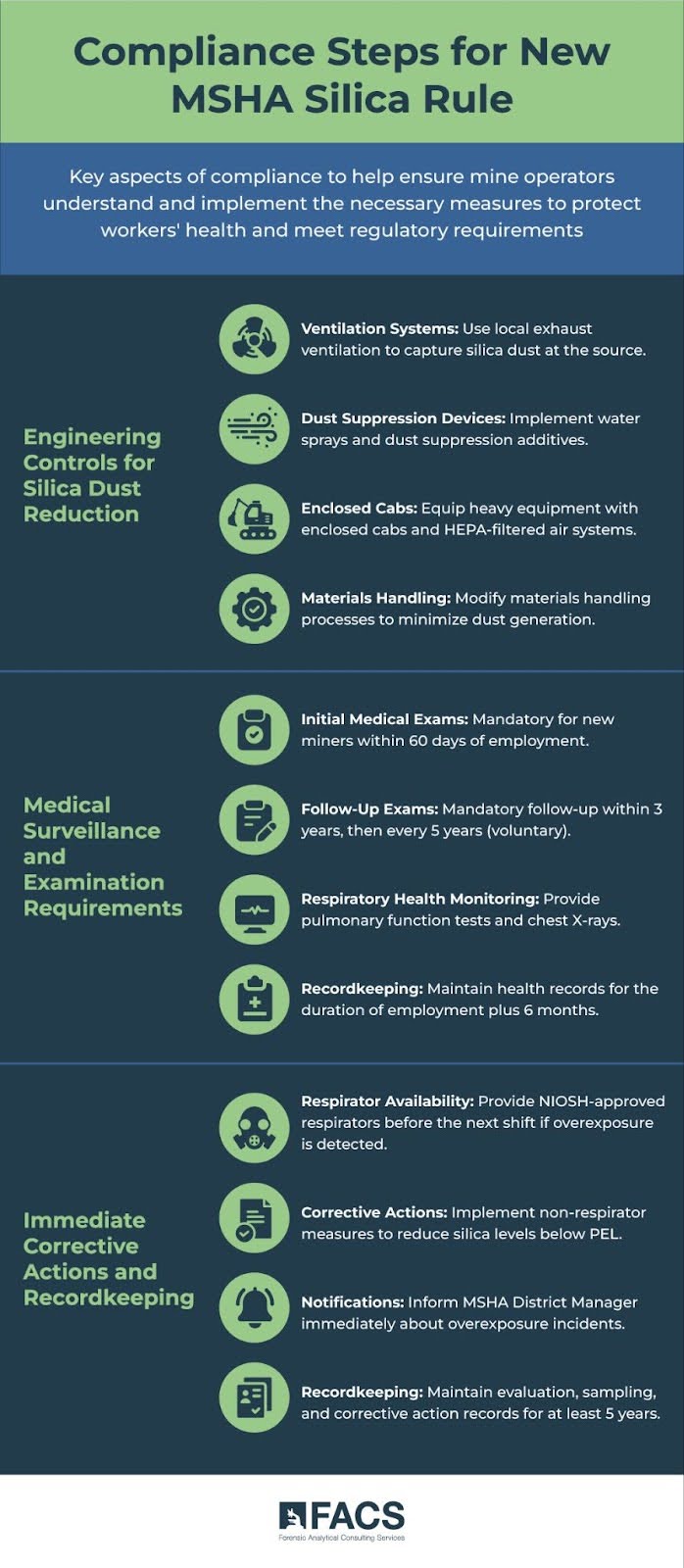The Mine Safety and Health Administration (MSHA) recently updated its standard on respirable crystalline silica (RCS) that took effect on June 17, 2024. These changes follow extensive review of testimonies and written comments from a broad range of stakeholders.
Companies operating any mine (metal, non-metal or coal), quarries, sand, gravel, and other aggregate activities should know and apply the new requirements to remain in compliance with federal law.
Below is a summary of the major provisions in the final rule.

Key Changes under the New MSHA Silica Rule
Establishes a Uniform Permissible Exposure Limit and Action Level: The rule sets a uniform permissible exposure limit (PEL) for respirable crystalline silica at 50 micrograms per cubic meter of air (µg/m³) over an 8-hour time-weighted average shift (TWA). This aligns with the PEL required by the Occupational Safety and Health Administration (OSHA), which was published in March 2016.
Additionally, an action level (AL) of 25 µg/m³ calculated over an 8-hour TWA has also been established. The new PEL and AL apply to all three forms of respirable crystalline silica either alone or in any combination (i.e., quartz, cristobalite, and/or tridymite).
Requires Exposure Monitoring: Operators must commence sampling for any miner who is expected to be exposed to respirable crystalline silica. MSHA eliminated the use of objective or historical sample data to establish a baseline of silica exposure in the final rule. If initial samples are below the action level, additional sampling is still required within three months to confirm compliance.
Mine operators must also sample with equipment that is designed to conform to ISO 7708:1995(E) standard. Additionally, mine operators are required to use laboratories accredited to ISO/IEC 17025 to analyze samples for respirable crystalline silica using an analytical method specified by MSHA, OSHA or NIOSH.
Recordkeeping requirements: Records pertaining to sampling must be posted on mine bulletin boards and by electronic means (if applicable) for 31 days upon receipt. The records must include the sample date, occupations sampled, and concentrations of respirable crystalline silica found.
Additionally, all evaluations, sampling and corrective action records need to be stored for at least five years under the new rule.
Mandates Immediate Reporting and Corrective Action: Mine operators must immediately report any overexposure to RCS and take steps to reduce the concentration of respirable crystalline silica to below the PEL.
The mine operator must make approved respirators available to affected workers before the start of the next work shift and ensure the respirators are worn for the full shift or during the period of overexposure until miner exposures are at or below the PEL.
Corrective actions must be taken immediately to lower the concentration of RCS to at or below the PEL. If the sample exceeds the action level (AL), but is below the PEL, the operator can continue to operate, but must resample within three months. If the initial sample is below the AL the operator must sample again, at least seven days after and within three months to confirm compliance. This periodic sampling must continue until two successive samples demonstrate silica levels below the action level.
Requires Periodic Evaluations: Qualitative evaluations must be repeated at least every six months or whenever there is a change in production; processes; installation and maintenance of engineering controls; installation and maintenance of equipment; administrative controls; or geological conditions.
Engineering and Administrative Controls: Mine operators must implement feasible engineering controls as the primary method for controlling respirable crystalline silica. Administrative controls may be used as supplementary measures when necessary. The MSHA rule makes it clear compliance by engineering controls is preferred over administrative controls. Additionally, the final rule explicitly forbids the rotation of miners as an acceptable administrative control.
Respiratory Protection: The final rule incorporates the respirator standard of ASTM F3387-19 for all airborne contaminant standards. This standard applies to the selection, fit, use, and maintenance of approved respirators. Affected miners shall be provided with a suitable NIOSH-approved atmosphere-supplying respirator or NIOSH- approved air-purifying respirator equipped with particulate protection classified as 100 series under 42 CFR part 84 or particulate protection classified as High Efficiency ‘‘HE’’ under 42 CFR part 84. N95’s are no longer an option. Additionally, mine operators must have a written respiratory protection program in line with the standard.
The final rule does not allow the use of respiratory protection for compliance although it does acknowledge that respiratory protection protects miners from silica, therefore allowing the use of respiratory protection while engineering controls are developed and implemented if respiratory protection is necessary by the nature of the work.
Medical Surveillance Requirements: The final rule includes a provision for metal and non metal operators to provide regular medical examinations to all miners at no cost. The medical surveillance programs are designed to be similar to those already required for coal miners under the existing standard. The medical surveillance requirements are intended to improve early detection of respiratory illnesses, including diseases related to respirable crystalline silica.
The new requirements became effective on June 17, 2024. Coal mine operators must comply within 12 months of the publication date. Metal and Non-Metal operators have 24 months to comply, allowing them additional time to meet the new standards while addressing the urgent need to protect miners’ health.
This comprehensive update to the MSHA’s silica rule aims to significantly reduce the health risks associated with respirable crystalline silica exposure in the mining industry. In a press release announcing the rule, MSHA emphasized the hazards associated with the inhalation of respirable crystalline silica and concluded that the rule change will result in over 1,000 avoided deaths and almost 4,000 avoided cases of silica-related illnesses.
The respirable crystalline silica final rule is now in effect and operators can begin early sampling today. For help complying with the new regulations contact FACS by telephone at 888-711-9998 or use our contact form.